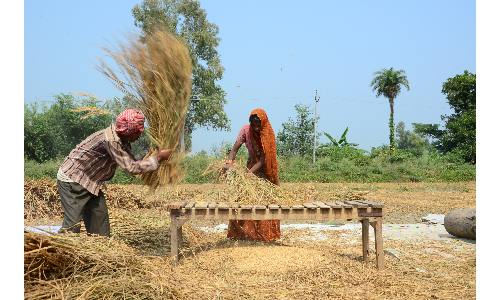History of food rooted in old, extraordinary agriculture traditions
Food production might have evolved and improved dramatically over time, yet, some of the ancient ways of producing crops have a lot to teach us.
 गाँव कनेक्शन 21 May 2018 10:45 AM GMT
गाँव कनेक्शन 21 May 2018 10:45 AM GMT

Food as we know it today has a great story of existence to tell. Don't be surprised to know that some of our staple foods actually come from extraordinary agricultural traditions that are deeply rooted in our cultures and identity.
The traditional ways of cultivation took care of aspects like protecting the environment, being sustainable and adapting to climatic change. We are referring to rice, dates, and tea that have existed for more than 10,000 years on Earth.
Food production might have evolved and improved dramatically over time, yet, some of the ancient ways of producing crops have a lot to teach us.
रहट सिंचाई जानते हैं क्या होती है? बिना डीजल और बिजली के निकलता था पानी
Conservation of natural resources, sustainable agriculture and agroecology are not only techniques for preserving what the earth has given us, they are also ways of conceptualizing how humans interact with nature. There are communities around the world that have always thought this way, using their land and planning their agricultural activities accordingly.
The Food and Agriculture Organisation of the United Nations runs the Globally Important Agricultural Heritage Systems programme, to recognize and preserve such traditions that combine agriculture and heritage, sustainability and livelihoods, environmental sensitivity and adaptation to climate change.
सिंचाई के लिए कमाल का है यह बर्षा पंप , न बिजली की जरूरत और न ही ईंधन की
Currently, there are 50 designated sites in 20 countries around the world that fall under their purview.
We bring to you first in the series of the foods whose tradition is being seriously looked into and conserved
Rice
Rice is known to be a staple grain for more than half the world's population. Asia is the largest rice producing and consuming region. Over the years, rice has come to become an important staple throughout Africa as well. No wonder this grain has a rich tradition and history behind its origins.
From the production perspective, as an agriculture commodity, rice has the third highest worldwide production, after sugarcane and maize. The earliest forms of rice were grown in China around 5000 years back. In fact, the rice paddy was first invented by the Chinese farmers. The rice paddy was grown in an artificial pond, thereby saving water and also helping in killing the weeds.
It is also believed that rice roots were discovered in India in 3000 BC, when some native people discovered the plant and began to experiment with it for their personal use. From China, the production of rice soon spread to the other parts of the world, including India, Greece, Southern Europe and many parts of North Africa. In India, people during the Harappan civilization began to grow rice by around 2500 BC. The Spanish brought rice in the beginning of the 18th century to South America.
धान की खेती की पूरी जानकारी, कैसे कम करें लागत और कमाएं ज्यादा मुनाफा
Today, in China alone, there are five different rice production sites that FAO has recognised as important agricultural heritage systems. One of these systems are the Hani Rice Terraces. In the Yunnan province of China, the Hani people have been living and working on the land for over 1,300 years.
They have built amazing terraces, covering 70,000 hectares of land, on steep mountainsides and have done so without any water reservoirs. The Hani people utilize and manage local water resources in an innovative and efficient manner. Terraces are not only an agricultural tradition, they are a sustainable and innovative way of farming difficult landscapes.
Rice terraces exist in many countries worldwide and two other countries also have ones recognized as agricultural heritage systems: The Gudeuljang Irrigated Rice Terraces in Cheongsando, Korea and the Ifugao Rice Terraces in the Philippines.
Originally reported by www.indoasiancommodities.com and published under a content sharing arrangement.
Next Story
More Stories




